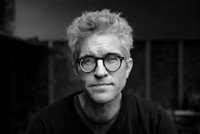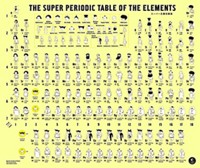Advertisement
Grab your lab coat. Let's get started
Welcome!
Welcome!
Create an account below to get 6 C&EN articles per month, receive newsletters and more - all free.
It seems this is your first time logging in online. Please enter the following information to continue.
As an ACS member you automatically get access to this site. All we need is few more details to create your reading experience.
Not you? Sign in with a different account.
Not you? Sign in with a different account.
ERROR 1
ERROR 1
ERROR 2
ERROR 2
ERROR 2
ERROR 2
ERROR 2
Password and Confirm password must match.
If you have an ACS member number, please enter it here so we can link this account to your membership. (optional)
ERROR 2
ACS values your privacy. By submitting your information, you are gaining access to C&EN and subscribing to our weekly newsletter. We use the information you provide to make your reading experience better, and we will never sell your data to third party members.
Profiles
Sam Kean’s latest book explores the molecules we breathe
Author shares what he learned while writing ‘Caesar’s Last Breath’
by Sam Lemonick
July 3, 2017
| A version of this story appeared in
Volume 95, Issue 28
Breathe in. Statistically, that and every other breath you’ll ever take contains one of the roughly 25 sextillion molecules that Julius Caesar exhaled in his dying breath.
That mind-boggling fact sets the stage for author Sam Kean’s latest book, appropriately titled “Caesar’s Last Breath: Decoding the Secrets of the Air Around Us.” Kean explores the components of the air we breathe with a stream of anecdotes about the science and scientists behind the molecules that make up our atmosphere. He takes the reader on a journey that wends through the early, fiery days on planet Earth to the atomic tests at Bikini Atoll, and from tumor surgery in a Boston operating theater to UFO landings in Roswell, N.M.
After his first book, “The Disappearing Spoon,” about the elements, Kean took a break from chemistry, writing about genetics and the brain instead. Now he’s returned to the subject, sitting down with C&EN to talk about the new book, out July 18.
Have you been thinking about gases for a long time?
Definitely. It’s one of the first basic facts you know: Some things are liquids, some are solids, and some are gases. But you probably pay the least attention to the gases around you, which is a little weird, as I mention in the book, because you can go a week or two without food—without solid things. Without water you can go a day or two. But you won’t make it a few minutes if you don’t have air. We kind of neglect the air.
It took humanity a long time to figure out what gases were, to get their heads wrapped around the whole idea of them. The word gas actually comes from the word chaos in Greek. And gases were considered these almost wild spirits that no one could tame. It took a while for us to bring them under the heading of normal, everyday matter that we could study in any scientific way.
Vitals
Age: 38
Lives in: Washington, D.C.
Time to research and write “Caesar’s Last Breath”: two years
Previous work: Kean has written three previous books about the history of science, as well as articles for the New York Times Magazine, the Atlantic, and other outlets.
Inspiration for “Caesar’s Last Breath:” Kean always wanted to learn more about gases, and writing a book, he says, is a good—if “slightly foolhardy”—way to learn a lot very quickly.
This is as much a book about people as it is about gases. The chapter on nitrous oxide describes the development of anesthesia and some pretty interesting characters who helped introduce it into medical practice. How did you navigate the line between telling human stories and talking about the science of gases?
The emphasis for me was to make sure there were stories about scientists, about people. I wanted there to be heroes and villains, for there to be conflict. Covering a different gas we breathe in each chapter, I knew the science would find its way in there based on what the scientists were doing. But I wanted to make sure that the stories were the primary thing that I was focusing on.
There definitely are heroes and villains and other archetypes. Alvin Graves, who helped develop atomic weapons, comes off as kind of monstrous, and Irving Langmuir, who late in his life experimented with seeding clouds to make rain, seems like a bit of a nut. What impression do you think readers will get about the kind of person a scientist is from the book?
Hopefully, they think of them as very human. There are some heroes in the book, great scientists who do some amazing things, and there are some scientists who are very flawed people. I think in the general public’s eye there’s a sort of stereotype about scientists, that they’re hyperrational people and possibly even a little bloodless. But scientists are people just like everyone else.
Most scientists have noble motivations. But sometimes you read about scientists who have awful motivations, and they’re sometimes not very good people. Or sometimes, like in the case of Langmuir, you have a great scientist who kind of goes off the rails. Toward the end of his life he got fixated on this idea of being able to control the weather. I don’t think it undid all the great science he did, but it does show you that even the ones who do great science can fall prey to all the enthusiasms and self-delusions that other people fall prey to as well.
Each chapter opens with ball-and-stick illustrations of some of the gases you’re going to discuss. I liked that. What made you add those?
We wanted to make sure that people could visualize the gases. It’s hard sometimes because air is invisible, and human beings are fairly visual creatures. So I think it helps to have that little model in mind.
Were you more aware of gases in your daily life while you were researching and writing “Caesar’s Last Breath”?
It was something that made me stop and think. A breeze goes by, and instead of disregarding it or bundling up, I’d think a little more about it. Where’s it coming from, what is it bringing, could I smell anything on it? When you start to write about a topic like this and focus on it for week after week, it does start to change your thinking about it. You start to notice these everyday actions that you’d be more likely to disregard if you weren’t paying attention to it in the book.
What part of the book stayed with you after you were done writing?
One thing that stuck with me was realizing how certain events, like volcanic eruptions and nuclear fallout, spread across the globe, and how thoroughly different parts of the atmosphere are connected. Gases released from volcanoes spread around Earth and cause pressure fluctuations that people can see on a regular basis for days and days. They can watch their barometers go up and down based on this eruption on the other side of the world. It was similar with fallout spreading around the world: You can’t go anywhere nowadays, even Antarctica, without encountering fallout from nuclear bomb tests in the 1950s and ’60s, especially.
Late in the book you talk about greenhouse gases and climate change, and you switch to a first-person voice to describe your views on climate engineering, which are projects to reverse the effects of global warming. Why did you decide to step into the book like that?
Most of the book is about historical things. The facts aren’t settled necessarily, but there’s generally a consensus about them. On the other hand, climate change is something that’s still ongoing. With climate engineering, it’s controversial, and I don’t anticipate that everyone is going to agree. I wanted to make it clear that it’s my opinion, as opposed to something that’s a matter of scientific or historical record.
I think a lot of us have this struggle with [climate change]. There’s an overwhelming scientific consensus about the reality of climate change, but the question of what to do is a lot harder. I talk in the book about my skepticism that human beings are going to stop producing and consuming. I don’t necessarily think climate engineering is a great idea, but from a practical sense it seems like that’s more realistically going to happen than humans voluntarily giving up consumption. I think by introducing it as my point of view it will help foster discussions.
Sam Lemonick is a freelance science writer based in Berkeley, Calif. This interview was edited for length and clarity.






Join the conversation
Contact the reporter
Submit a Letter to the Editor for publication
Engage with us on Twitter